Home
Main
THE STATION
Where are we
The station
History
THE TEAM
The crews
Training
Exercises
IN ACTION
The fleet
Divers
Covered area
events
SOS CALLS
Rescues
The System
Press
WE NEED YOU
Join us
Help us
Links
E-Mail
|
|
THE
FLEET
These
lifeboats fit in these two classes at the same time. They are designed
to operate at high sea rescues as well as at those occurring at the coast
and cliffs.they usually have rigid hulls and a cabin housing the weel-house.
Appart from this, this lifeboats have good acceleration response and excelent
cappabilities for manoeuvring . They normally are fitted with two engines
and have an extended range.
Because
of these features we employ our class A-B lifeboat not only for rescues
at high seas, but also as an advanced coordination center for sea and underwater
search tasks.
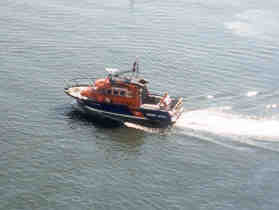 |
|
DHUBE
Length: 12 mts.
Beam:
Displacement: 9 TnB.
Maximum Speed:
27
knots
Range:
Crew: 4 - 5
Engine:
2x Cummins
300 H.P.
with Castoldi Jets. |
A MAG-10 Vedette model
lifeboat, entirely built in aluminum alloy, with complete self righting
capability thanks to the auxiliary raft carried on her top.
She is propelled by two
Cummins engines, 300 HP each, which move a couple of CastoldiJet fans instead
of the more traditional propellers.
This system has obvious
safety advantages when working with divers, at shallow waters, or between
ropes and wires, where propellers would have big chances of getting tangled.
This also provides the lifeboat with an incredible maneuverability, impossible
to achieve in case of using propellers.
Electronics: Three
VHF radios (two in the sea band and the other at 27 MHz), another one at
2182 KHz, goniometer, NAVTEX for the reception of weather reports and warnings,
GPS, plotter, echo-sounder, RADAR and a distress signal buoy, according
to the COSPAS-SARSAT system.
Equipment: Search
lights, towing equipment, water pump for taking water out or fire fighting,
life raft and survival equipment, life buoys and rescue material, line
throwing devices, and a small Zodiac inflatable raft, fitted with an Evinrude
engine of 15 HP. This raft is stowed on the top of the lifeboat and is
very useful at shallow water rescue operations.
Paramedical equipment:
Three beds, spinal back-board and nest stretcher, paramedical and medical
material boxes, rigid and vacuum splints, extrication collars, resuscitation
equipment, semi-automatic defibrillator, and oxigenotherapy equipment. |
Fast
response lifeboats, used for rescues at the coastline. This is why they
are preferred to be semi rigid and to be propelled by one or two very powerful
outboard engines, in order to be able to operate in the dangerous waters
surrounding the reefs and the rocks at the cliffs.
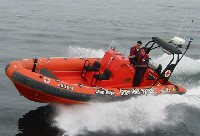 |
|
ARRILUZE
III
Length: 7.30 m.
Beam: 2.8 m.
Displacement:
Maximum speed: 37
knots.
Range:
Crew: 3 - 4
Engine: 1x IVECO
200 C.V. Intraborda. |
| Our
newest lifeboat, who made her maiden launch in June 2004, is a Zodiac Hurricane
7.30 equipped with a "Z-Drive" type of engine and cappable for self-righting.
Electronics: VHF wireless,
echo-sounder, GPS, Plotter and Radar.
Equipamiento: Search
light, water rescue buoys, towing equipment, and available space for a
stretcher.
Equipo sanitario:
Paramedical tool box, spinal back-board and nest stretcher, splints, extrication
collars, resuscitation and oxigenotherapy equipment. |
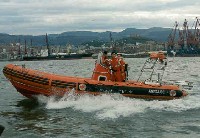
|
|
ARRILUZE II
Length: 7.30
mts. Beam:
Displacement: 3 TnB.
Maximum Speed:
35
knots
Range:
Crew: 3 - 4
Engine: 2x Evinrude
Fitch 115 H.P. |
| This one is a Duharry
Cormorán 7.30 CR. She was named as "Arriluze II" in memory of the
unfortunate "Arriluze", lost during a rescue in 1995. She has self righting
capability as well.
Electronics: VHF wireless,
echo-sounder and GPS.
Equipment: Search
light, water rescue buoys, towing equipment, and support for a stretcher,
but she can carry three.
Paramedical equipment:
Paramedical tool box, spinal back-board and nest stretcher, splints,
extrication collars, resuscitation and oxigenotherapy equipment. |
 |
|
BILBAO
Length: 7.50
mts. Beam:
Displacement: 3 TnB.
Maximum Speed:
40
knots
Range:
Crew: 3 - 4
Engine: 1x Evinrude
Fitch 150 H.P. |
| This one is a Bombard
Explorer 7.60 and is fitted with an electronic injection outboard engine.
Electronics: VHF wireless,
echo-sounder and GPS.
Equipment: search
light, water rescue buoy, and towing equipment.
Paramedical equipment:
Paramedical tool box, spinal back-board and nest stretcher, splints, extrication
collars, resuscitation and oxigenotherapy equipment. |
These
small lifeboats are intended for inshore rescues, so they are all small,
light crafts, fitted with a single outboard engine and capable to be transported
by road to the place of the distress. Their main tasks are rescues at rivers
and covering of sport or popular events at harbors or inner waters.
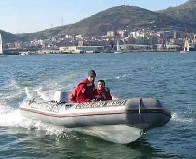 |
|
SABINA
Length: 4.5
mts. Beam:
Displacement:
Maximum Speed:
22
knots
Range:
Crew: 2 - 3
Engine: 1x Honda
35 H.P. 4 stroke. |
This one is a Zodiac
Pro 4.5, with Non-Stop balloons, employed mainly to cover popular and sport
events at inner waters, or rescues at shallow water coastlines.
It is also used by the
underwater rescue team for searches in rivers, as well as in floods.
Electronics: She has
no radio and therefore sea band walkie-talkies are employed.
Paramedical equipment:
Paramedical tool box. Other equipment is also carried according to what
is requiered for each particular situation. |
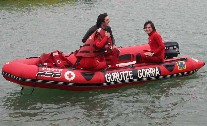 |
|
EREAGA
Length: 4.20
mts. Beam:
Displacement:
Maximum Speed:
20
knots
Range:
Crew: 2 - 3
Engine: 1x Evinrude
30 H.P. |
| Another Zodiac Pro 4
with Non-Stop balloons, mainly used for covering competitions and popular
events, but also for emergencies at rivers or inner seas and shallow water
coastline.
Electronics: Similar
to our previous ship, she has no radio and therefore sea band walkie-talkies
are employed for communications.
Paramedical equipment:
Paramedical tool box. Other equipment is also carried according to what
is requiered for each particular situation. |
Sometimes
the rescue must be done from the ground, because of the impossibility of
accessing from the sea or because the rescue scenario is at inner waters
(rivers, lakes or dams). Some other times the rescue is done from the sea
but it is convenient to count with a help from the ground, in order to
guide the lifeboat in her maneuvers.
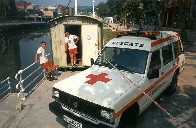 |
|
NISSAN PATROL
Length:
Weight:
Range:
Engine:
Equipment: Botikinak,
bilaketetarako linternak, palak, sokak,...etab. |
It is very useful for
difficult rescues that require help from the ground for guidance, and also
to carry the C class lifeboats and the rescue divers to the place of a
particular incident.
It can tow a trailer
with all the material needed for specific rescues: line throwing devices,
a Breeches buoy, pikes and shovels, light cannons, etc... |
|
|
|

